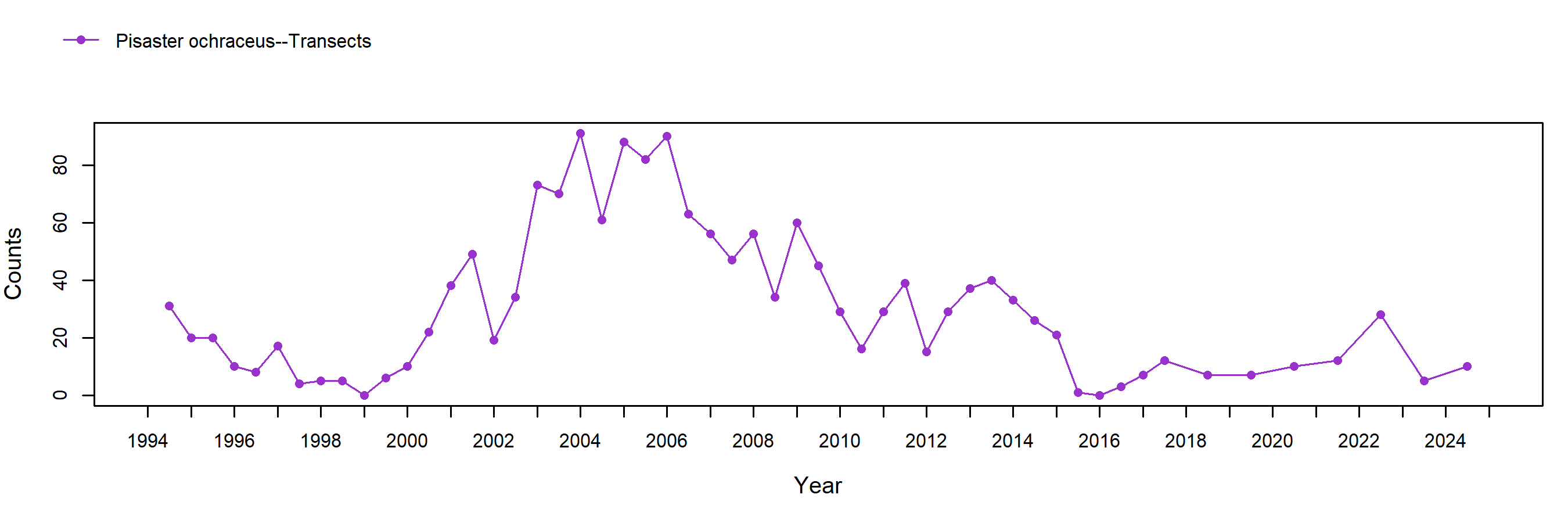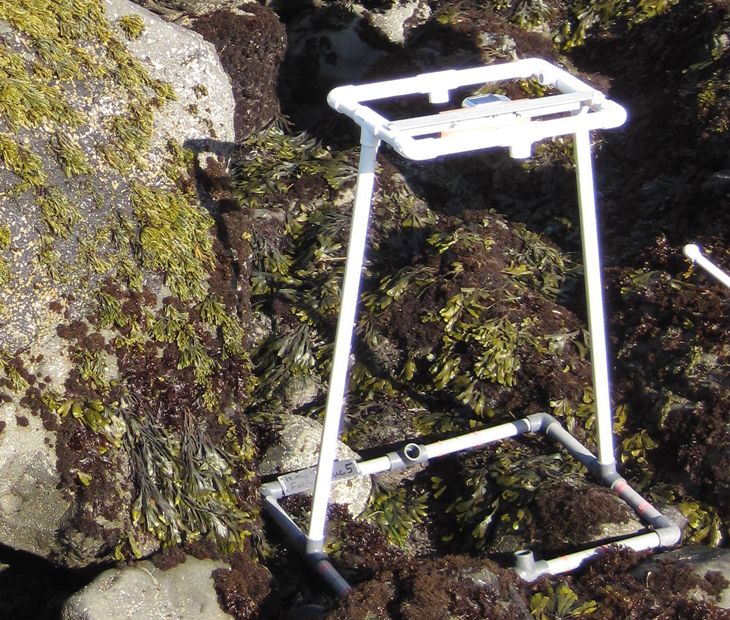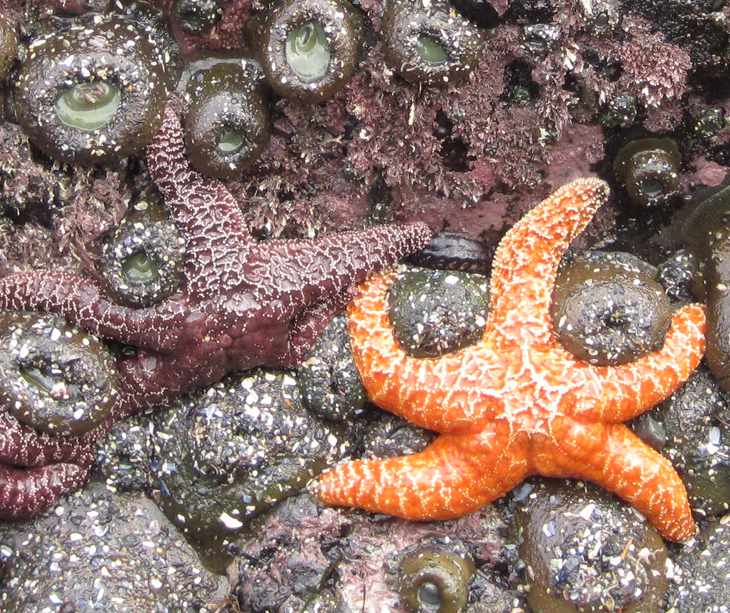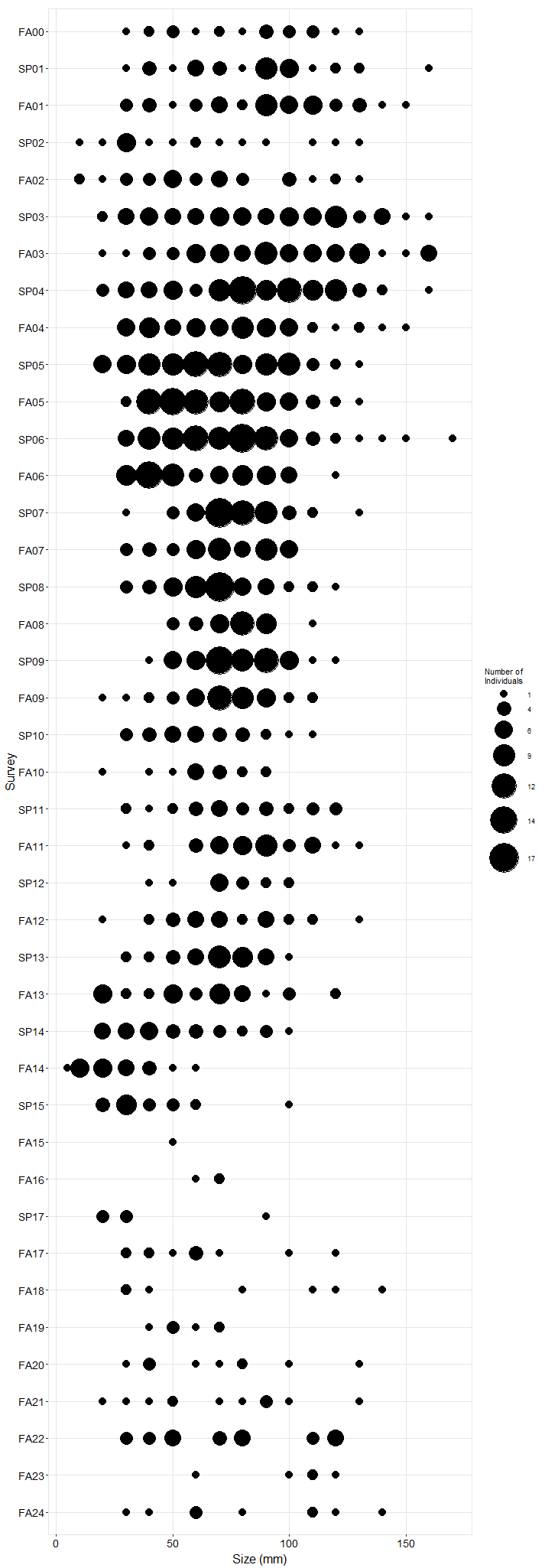Old Stairs Long-Term trends | MARINe
Old Stairs Long-Term trends
See below for trend graphs
In order to standardize species resolution across all MARINe groups, and over time, some species (typically rare) were lumped for graphical presentation of Long-Term monitoring data. See lumped categories for definitions (some variation occurs between methods and over time). Due to funding constraints, semi-annual sampling of plots/transects was reduced to annual sampling beginning in 2016.
Anthopleura anemone plots at Old Stairs consist primarily of the colonial anemone, Anthopleura elegantissima, rather than the solitary anemone, Anthopleura sola (note that these were considered a single species for the first ~decade of sampling and they are not distinguished in sampling methods). The cover of anemones was relatively static from 1994 to 2015 (~40-60%) with a notable drop in cover in spring 2002. Since 2015, anemones have declined slowly, reaching near 25% in fall 2018. Sand inundation occurred sporadically during the first decade, with peaks in sand cover from 1996-97 and in 2002, resulting in a decline in Anthopleura cover. During periods of lower anemone cover, other invertebrate species (primarily Phragmatopoma and encrusting tunicates) and red algal species (namely Chondracanthus spp. and filamentous taxa) exhibited slight increases. Mussels (Mytilus) were present periodically throughout the sampling period, reaching peaks of almost 20% cover in 2000 and 2005. Mussel cover began increasing in 2016, reaching almost 40% by fall 2018.
Chthamalus/Balanus barnacle plots consist of a mixture of Chthamalus dalli/fissus (note that species were not distinguished until 2001) and Balanus glandula, with the former being the dominant component of all plots. Initially, barnacle cover was high (~95%) but slowly declined over time through 2015 (reaching <20% cover), although with some interannual variability. Barnacles have moderately increased from 2015 through fall 2018, reaching ~40%. A single plot, which has remained at nearly 100% barnacle cover throughout the years, has been responsible for maintaining moderate levels of mean cover among plots. The other four plots exhibited long periods of relatively high cover of Endocladia and/or Mytilus, along with bare rock. In 2014, however, Endocladia started to decline and reached near zero in fall 2018. Within the barnacle plots, the counts of Littorine snails and limpets yielded high densities, with snail abundances varying between ~500-1,000 individuals per plot and limpets remaining steady at around 100 individuals per plot. Nucella snails were also common on occasion (~10 individuals per plot), though these were absent during three sampling events.
Mytilus mussel plots consisted initially of higher mussel cover (~80%) but declined precipitous to ~30% between spring and fall 1995. This decline corresponded with increased barnacle and bare rock cover. Starting in 1997, mussels began a gradual recovery, interrupted by brief declines of varying degrees in 2004-2005, 2009, and 2015, as a result of breakouts in the mussel beds, presumably due to heavy winter storms. Consistent recruitment of young mussels to this site has allowed these mussel beds to regenerate before other opportunistic species become established in the plots. Barnacle cover was relatively low (<20%) throughout most of the study period, with exceptions of peaks in 1996 and 2004/2005 when mussel cover exhibited large declines. Sand was mostly absent throughout the study period, although reached 30% cover in spring 1997. Motile invertebrate counts reveal relatively high numbers of limpets, ranging from 50-150 individuals per plot, although limpet numbers initially were low. Counts of chitons (Nuttalina spp.), Littorine snails, and whelks (Nucella spp.) were consistently low over the years. Limpets and Littorine snails were not counted in spring 2014.
Endocladia turfweed plots consisted of a diverse mixture of turfweed, barnacles, mussels, and bare rock with no clear patterns developing throughout most of the monitoring period. However, starting in 2014, plots became dominated by bare rock while Endocladia practically disappeared and barnacle and mussel cover was relatively low. Counts of limpets in turfweed plots were high, ranging from 200-400 individuals per plot, with a peak of ~500 in spring 2012 and a low of ~150 in spring 2010. Littorine snail counts were highly variable, reaching over 200 individuals per plot in 2003, 2008, and 2012. During other years, Littorines ranged between 20-100 individuals. Densities of chitons (Nuttalina spp.) and whelks (Nucella spp.) were consistently low throughout the sampling period.
Rock ("Above Barnacles") plots were added to this site in the fall of 2008 to document any upward spread of intertidal species as a result of sea level rise or other factors. These plots were expected to remain dominated by bare substrate unless barnacles or other species shifted their zonal ranges higher into the splash zone. Barnacles were observed within plots since plot establishment, though cover has remained low; bare rock has been the dominant component (near 100% cover). Littorine snails were common, ranging from 150 to a peak of 450 individuals per plot in spring 2014.
Sea star (Pisaster ochraceus) abundance within transect swaths was ~30 individuals initially and remained slightly below that number for the first 5 years of sampling. After 2000, the number of seastars began to increase and become more variable, both among years and seasonally (with higher numbers in the spring compared to fall). Seastar counts reached a peak from 2004-2006 (~100 individuals) followed by a steady decline through 2014. In spring 2004, an additional protocol was established consisting of three large irregular plots, sampled concurrently with transect sampling. Plot sampling counted a high number of seastars (over 200) during the first several seasons of sampling, followed by declines to less than 50 stars by 2012. Abundances then increased slightly between 2012 and 2013 before dropping back to 50 individuals in spring 2014. While other sites in southern California were affected by seastar wasting disease as early as the summer of 2013, including documented disease related declines at sites upcoast and downcoast of this site, rapid declines likely attributable to wasting disease was not observed at Old Stairs until fall 2014. During fall 2014, most of the larger individuals were absent but a large number of young recruits were present. However, most of these seastars were not found during sampling in fall 2015, with low abundances remaining through spring 2017. Size measurements of seastars suggest the site was comprised primarily of mid to large sized individuals (50-100 mm) from 2000 to 2014, with a low frequency of very large seastars (<150 mm). Recruitment, as indicated by seastars less than 50 mm, was somewhat low but consistent over this time. The seastar population at Old Stairs prior to seastar wasting disease was likely maintained both through recruitment and through migration to and from the subtidal zone. Recruitment was relatively high during the period impacted by seastar wasting disease in spring 2014-2015, as compared to prior to the outbreak.
Photo Plots
Below are the trends observed for each Photo Plot target species at this site. Long-Term percent cover trend graphs also include any species that reached a minimum of 25% cover during any single point in time within a given target species assemblage. Breaks in trend lines represent missed sampling events. For additional species observed that did not meet this 25% threshold, please use the Interactive Map.
For motile invertebrate Species Counts, a mean across all plots was calculated, and only those species with a value of at least 5 individuals for at least one sample are shown. Due to time constraints, motile invertebrate counts have not been done at most sites since 2012. For motile invertebrate size trend graphs by site, please use the Interactive Map.
Anthopleura (Anemones)
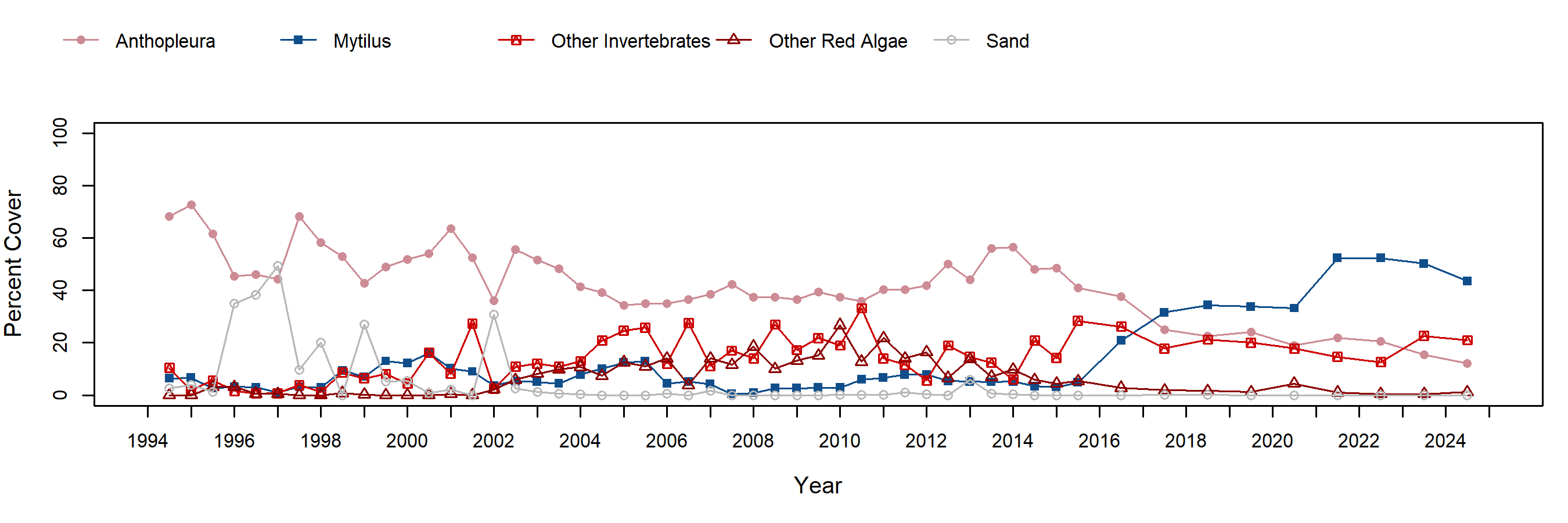
Chthamalus/Balanus (Acorn Barnacles) - percent cover

Chthamalus/Balanus (Acorn Barnacles) - motile invertebrate counts
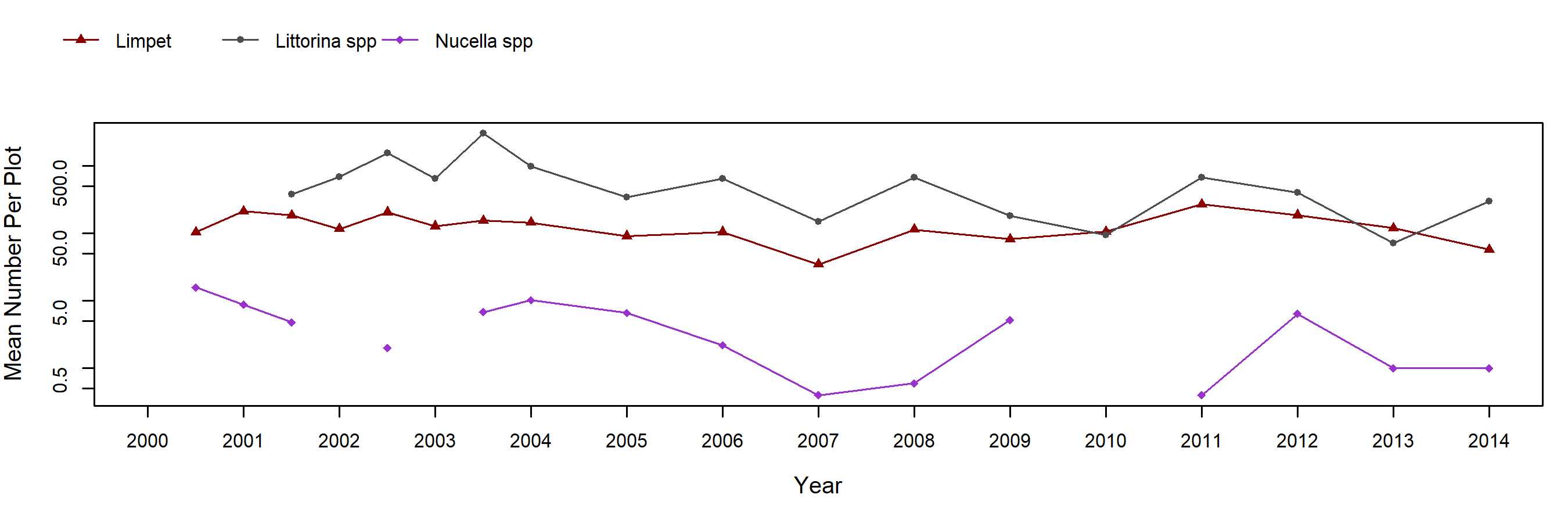
Mytilus (California Mussel) - percent cover
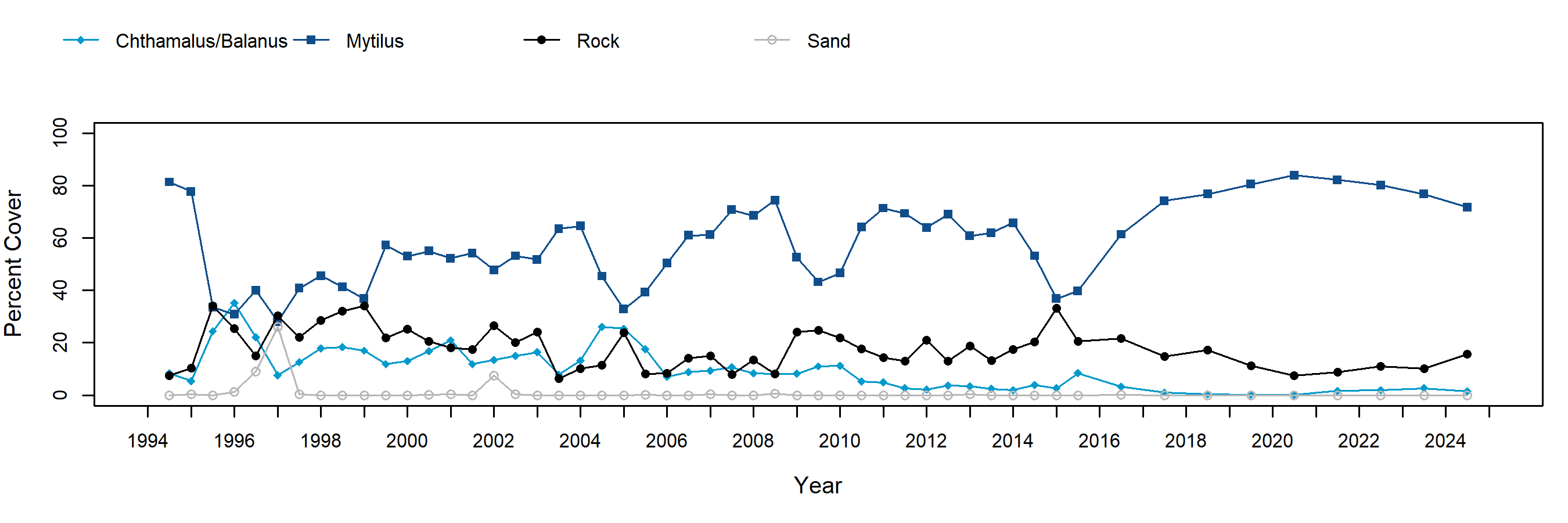
Mytilus (California Mussel) - motile invertebrate counts
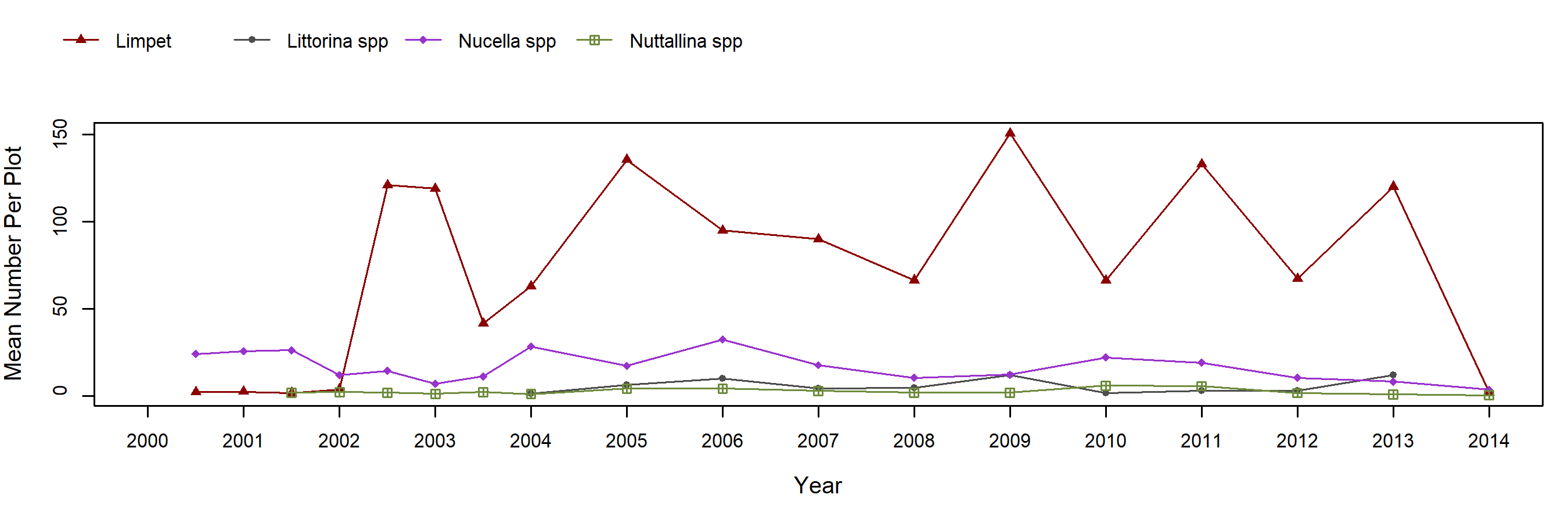
Endocladia (Turfweed) - percent cover
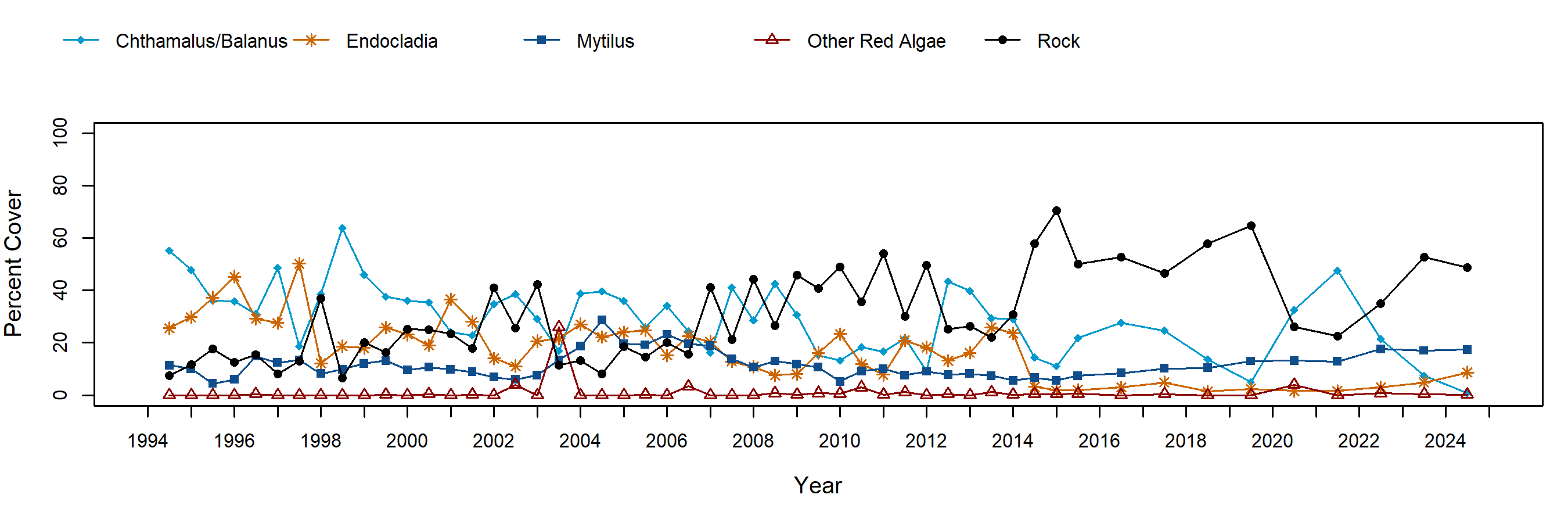
Endocladia (Turfweed) - motile invertebrate counts
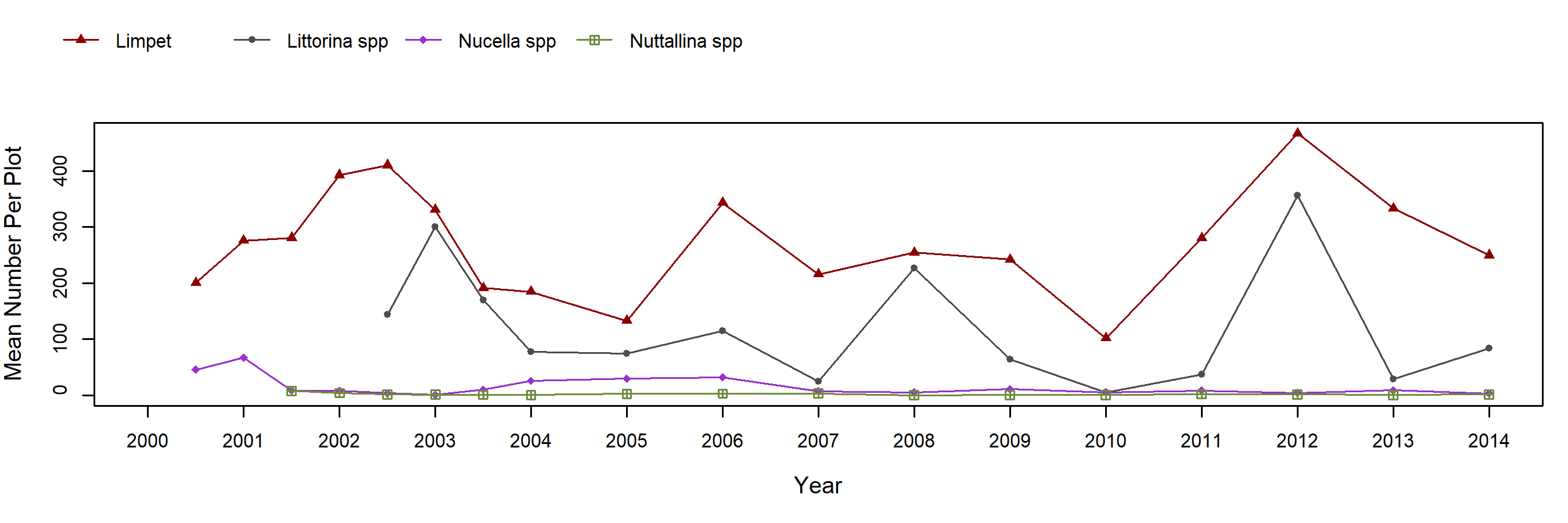
Rock (Above Barnacles) - percent cover
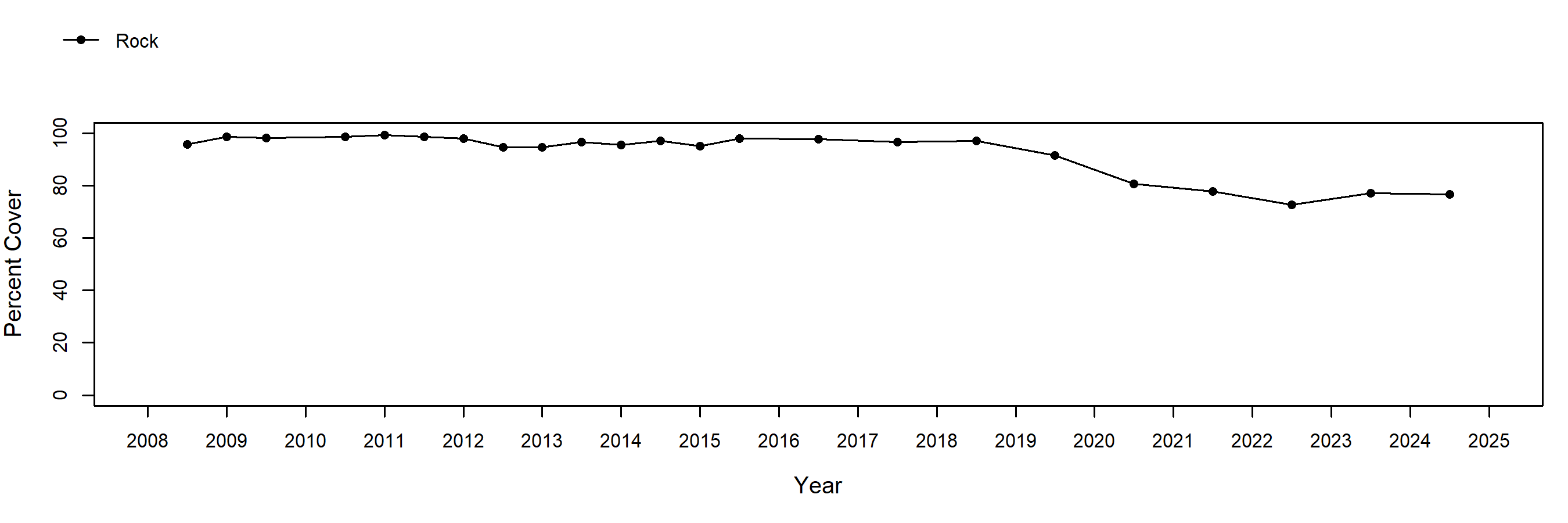
Rock (Above Barnacles) - motile invertebrate counts

Species Counts and Sizes
Species Counts and Sizes (where recorded) for Pisaster are shown below for this site. At some sites, other sea star species and Katharina are counted in addition to Pisaster. The sum of all individuals across all plots is displayed. Note that data gaps are represented by breaks in long-term count trend lines, but are not shown in size plots.
Pisaster (Ochre Star) - counts
